You are using an out of date browser. It may not display this or other websites correctly.
You should upgrade or use an alternative browser.
You should upgrade or use an alternative browser.
Can you help me identify some PV panels?
- Thread starter Perelho
- Start date
"Solar Module" isn't very helpful.
I've tried to hunt around and these seem to match the specs for some panels being sold from a "boat" shop. Also, the inverter which was available as a separate purchase I have seen mentioned in a For Sale listing of a river boat house. So I'm assuming these were installed on a boat originally.
I've tried to hunt around and these seem to match the specs for some panels being sold from a "boat" shop. Also, the inverter which was available as a separate purchase I have seen mentioned in a For Sale listing of a river boat house. So I'm assuming these were installed on a boat originally.
Attachments
-
 9CAC3761-5872-444E-836C-202005C81ADD.jpeg197.3 KB · Views: 9
9CAC3761-5872-444E-836C-202005C81ADD.jpeg197.3 KB · Views: 9 -
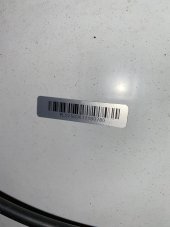 FEB19AEC-AEC2-47FF-94BD-74652479C45F.jpeg112.6 KB · Views: 21
FEB19AEC-AEC2-47FF-94BD-74652479C45F.jpeg112.6 KB · Views: 21 -
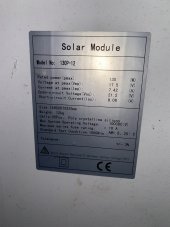 8795A3D4-A690-4321-A32B-FBAB1493E80B.jpeg120.6 KB · Views: 23
8795A3D4-A690-4321-A32B-FBAB1493E80B.jpeg120.6 KB · Views: 23 -
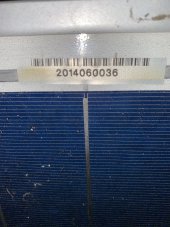 3C2017F0-E13C-4CD5-A985-BE3D610F5BC2.jpeg180.3 KB · Views: 26
3C2017F0-E13C-4CD5-A985-BE3D610F5BC2.jpeg180.3 KB · Views: 26 -
 59A44A9D-F072-4D8E-9878-E75559592DD6.jpeg131.2 KB · Views: 17
59A44A9D-F072-4D8E-9878-E75559592DD6.jpeg131.2 KB · Views: 17 -
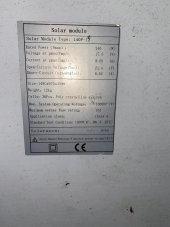 9F5C44D8-33FD-4A5B-9E90-2E1D13108FDD.jpeg143.7 KB · Views: 17
9F5C44D8-33FD-4A5B-9E90-2E1D13108FDD.jpeg143.7 KB · Views: 17 -
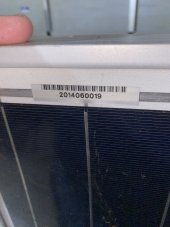 96609DED-1405-42E2-8FDE-6D7CF51F9023.jpeg146.3 KB · Views: 14
96609DED-1405-42E2-8FDE-6D7CF51F9023.jpeg146.3 KB · Views: 14
Here is the page for the panels I suspect these are.

 www.whitworths.com.au
www.whitworths.com.au
Still... very open to suggestions of other possible matches.
I know they're not in the best condition, and what brand they truly are is probably inconsequential in the long run, but I'd still like to know.

Sunyo Polycrystalline Solar Panel
SUNYO Solar module is a robust all-purpose solar module with high efficiency solar cell. These modules can be used for off-grid residential or commercial applications. Meticulous design and production techniques ensure a high-yield, long term performance
Still... very open to suggestions of other possible matches.
I know they're not in the best condition, and what brand they truly are is probably inconsequential in the long run, but I'd still like to know.
TomC4306
Solar Obsessive
Everything you need to know is on that label. Keep reading on this forum, searching the forum for specific questions previously asked. Read, read, read.
This is an A, and this is a B, type help has been given on here before and you can find it if you search for it.
I suggest people go to the library and read a basic electronics book first before they "I've decided to (very slowly) dip my toes into the solar power arena"
This is an A, and this is a B, type help has been given on here before and you can find it if you search for it.
I suggest people go to the library and read a basic electronics book first before they "I've decided to (very slowly) dip my toes into the solar power arena"
MichaelK
Solar Wizard
Sadly, you way over paid. You should have offered 30$ per panel.
How many do you now have? Basically, they are more or less standard 12V panels so depending on how many you have you could use them for various applications. Keep in mind that even brand new panels may only put out 85% of their rated output, but in your case, before knowing what they can do, I'd suggest using 80% as a fudge-factor.
I'll throw some simple math at to give you and idea where to start. Depending on the application you want to do, you can vary the numbers inputted. The formulas stay the same.
So, a few parameters first.
Expect your panels to put out 80% of rated power when directly facing the sun. Maybe 50% of laying flat on a roof.
Lead-acid batteries like charging at 1/10 to 1/8 of C, with C being the Amphour (Ah) rating. They should not be drained less than 50%
Li batteries like charging up to 1/4 C. They should not be drained less than 20%
Batteries charge at a higher voltage than their rating. IE: 13V for a 12V battery, 26V for a 24V battery, ect.
Let's say you have a camper and you want to put the panels on the roof. You buy a 100Ah 12V battery to power the stuff inside the camper.
(100Ah/8fold) X 13V charging = 163W. To get 163W laying flat you need 163W/50% = 325W, or about two of those panels.
Those two panels have to be wired in parallel if you have a PWM charge controller, but could be wired in series if using a MPPT controller. The advantage of higher voltage serial panel connections is less power loss due to voltage drop, and thinner copper wire, which will be cheaper.
If you are putting 325W of panels on the roof, you need a controller that can handle 325W/13V = 25A. So, you might not want to buy a 20A max controller. Get a 30-40A rated controller, which would cost you around 115$ on Ebay. Make sure you buy a name brand, because there are a lot of fake Chinese controllers labeled as MPPT, but are only PWM.
As general rule of thumb, you only want to pull as much power out of a battery as the charging limit, so in the above case of a 100Ah battery, you don't want to pull out more than (100Ah/8) X 12V = 150W. If you want to power larger items, you need a larger battery. If you want a larger battery you need more watts of panels.
Hope that is helpful for you.
How many do you now have? Basically, they are more or less standard 12V panels so depending on how many you have you could use them for various applications. Keep in mind that even brand new panels may only put out 85% of their rated output, but in your case, before knowing what they can do, I'd suggest using 80% as a fudge-factor.
I'll throw some simple math at to give you and idea where to start. Depending on the application you want to do, you can vary the numbers inputted. The formulas stay the same.
So, a few parameters first.
Expect your panels to put out 80% of rated power when directly facing the sun. Maybe 50% of laying flat on a roof.
Lead-acid batteries like charging at 1/10 to 1/8 of C, with C being the Amphour (Ah) rating. They should not be drained less than 50%
Li batteries like charging up to 1/4 C. They should not be drained less than 20%
Batteries charge at a higher voltage than their rating. IE: 13V for a 12V battery, 26V for a 24V battery, ect.
Let's say you have a camper and you want to put the panels on the roof. You buy a 100Ah 12V battery to power the stuff inside the camper.
(100Ah/8fold) X 13V charging = 163W. To get 163W laying flat you need 163W/50% = 325W, or about two of those panels.
Those two panels have to be wired in parallel if you have a PWM charge controller, but could be wired in series if using a MPPT controller. The advantage of higher voltage serial panel connections is less power loss due to voltage drop, and thinner copper wire, which will be cheaper.
If you are putting 325W of panels on the roof, you need a controller that can handle 325W/13V = 25A. So, you might not want to buy a 20A max controller. Get a 30-40A rated controller, which would cost you around 115$ on Ebay. Make sure you buy a name brand, because there are a lot of fake Chinese controllers labeled as MPPT, but are only PWM.
As general rule of thumb, you only want to pull as much power out of a battery as the charging limit, so in the above case of a 100Ah battery, you don't want to pull out more than (100Ah/8) X 12V = 150W. If you want to power larger items, you need a larger battery. If you want a larger battery you need more watts of panels.
Hope that is helpful for you.
I got 6 panels (advertised as 130w panels) for a grand total of $60AUD. So I paid $10 each.
That gives a theoretical maximum of 780w. 2 of them are actually labelled as 140w. I guess it will be simpler to treat them as 130w panels though, unless I want to keep them as a separate system to the 130w panels. The numbers on the back label are very close for both 130w and 140w models.
The seller estimated them to be 15 years old, but at least half of them have a barcode on the that reads like: 20140600019, so I'm thinking they're more like half that age. He also said he was pulling around 1kw from them when he upgraded, which I seriously doubt. I haven't tested them yet, but I plan to do an open circuit voltage and short circuit amp test. We're getting some super hot weather here, (Chrsitmas day was 44C with 100% clear blue skies). But then, some of the panels have some "snail trails" through the cells, so I'm definitely NOT expecting any kind of good performance.
My intention is to use them to tinker around with various configurations. Basically get a hands on experience of the differences between parallel and series connections, PWM and MPPT charge controllers and various battery chemistries. Also, I watched Julian Ilett's Muppet (arduino implementation of a tracking DC-DC converter, essentially) and would like to tinker down to that level. Learn circuit design of the charger part that comes after the DC-DC converter, and implement those over time. Just because. Maybe learn how to implement a small BMS with active balancing, because... learning.
Yep, it's all been done many times. I learn best from doing though, so that is my plan.
That gives a theoretical maximum of 780w. 2 of them are actually labelled as 140w. I guess it will be simpler to treat them as 130w panels though, unless I want to keep them as a separate system to the 130w panels. The numbers on the back label are very close for both 130w and 140w models.
The seller estimated them to be 15 years old, but at least half of them have a barcode on the that reads like: 20140600019, so I'm thinking they're more like half that age. He also said he was pulling around 1kw from them when he upgraded, which I seriously doubt. I haven't tested them yet, but I plan to do an open circuit voltage and short circuit amp test. We're getting some super hot weather here, (Chrsitmas day was 44C with 100% clear blue skies). But then, some of the panels have some "snail trails" through the cells, so I'm definitely NOT expecting any kind of good performance.
My intention is to use them to tinker around with various configurations. Basically get a hands on experience of the differences between parallel and series connections, PWM and MPPT charge controllers and various battery chemistries. Also, I watched Julian Ilett's Muppet (arduino implementation of a tracking DC-DC converter, essentially) and would like to tinker down to that level. Learn circuit design of the charger part that comes after the DC-DC converter, and implement those over time. Just because. Maybe learn how to implement a small BMS with active balancing, because... learning.
Yep, it's all been done many times. I learn best from doing though, so that is my plan.
Last edited:
Those two panels have to be wired in parallel if you have a PWM charge controller, but could be wired in series if using a MPPT controller. The advantage of higher voltage serial panel connections is less power loss due to voltage drop, and thinner copper wire, which will be cheaper.
...
This... is learning right here. I've never heard of PWM being useful only in parallel, but I guess it makes sense. Thank you! I guess if you're crazy and have some "6v" panels (I'm talking those garden light or maybe IP camera or powered gate type panels), maybe series connection would make sense, because you need the PV supply to be above the battery charge voltage. But bringing that voltage up too high could be dangerous for the battery, and so parallel makes sense for panels which are individually already at that voltage level.
...
As general rule of thumb, you only want to pull as much power out of a battery as the charging limit, so in the above case of a 100Ah battery, you don't want to pull out more than (100Ah/8) X 12V = 150W. If you want to power larger items, you need a larger battery. If you want a larger battery you need more watts of panels.
Hope that is helpful for you.
I'm currently renting, and no room for a shed in the back yard, so for now it's just tinkering. The long term goal will be build my own house, with planned hybrid solar setup (so consideration for roof alignment, and sizing etc to allow for optimal North facing panel installation with plenty of room for panels, allowance for installation of the storage and chargers/inverters in a sensible place, 3-phase supply to the house, a dedicated EV charging circuit, for the inevitable future etc).
I know it's insane right now, but I'd like to get something like a 40kWh LTO battery system. Now, sizing of the panels for such a setup, is something I hope to learn over time. The idea of reducing the costs for maintaining (ie replacing the cells after their lifetime cycling is reached) is appealing. 20,000 - 30,000 cycles lifetime must have some huge possible savings when amortised over the lifetime of the cells. 55 years? Yes please! Something like a 30s16p using 35ah LTO cells for a 72v storage system.
I'm also planning to get an actual workshop sized shed built with the house. Tired of having no space and shuffling cars in and out of the garage to be able to work on projects. One thing I have imagined (not seen any videos on the idea yet) is to have the storage located in that workshop, away from the house, for possible safety benefits. I don't know if that makes sense, but it's rattling around in my head as something to look into. I'd hope to have a large panel install on the house, and supplemental panels on the workshop roof. Maybe all one big homogeneous system, or perhaps 2 discrete systems. I don't know. Maybe it would be beneficial to have a hybrid system in the workshop, to be able to cope with the lack of generation in winter (we're talking Aussie winter here, getting down to maybe 1C and very cloudy/rainy for months on end in Perth, and this will be part of my learning curve. How much does winter affect generation.)
Anyway, that's the plan. Gots to keep this big brain occupied, and why not find a way to drop our ever increase costs from relying on "state operated" power supply, and combustable fuels for our transport. Not really interested in supplying the grid, as FITs here are abysmal. Maybe that will change and fluctuate, with the possibility of traditional generation facilities going offline over time, but for now, I'd love to just use solar to power the house and future EVs completely, especially in the event of power outages due to scheduled utilities work, or some sort of "natural" disaster. (Imagine having a non-usable vehicle, or losing all your perishable foods, not being able to do basic human stuff because some clown decides to break the utility supply for days on end, or a wild fire takes out your local substation). We could even consider going for electric hot water and cook top (yecchhh!! We have gas water heating and stove top here) and ditch that ongoing cost also.
Last edited:
I'm confident I can skip this step. ?I suggest people go to the library and read a basic electronics book first before they "I've decided to (very slowly) dip my toes into the solar power arena"
Any opinions on buying the original inverter for $250AUD (circa $180USD)
It's a 12v DC, 240v AC 3000w inverter. It's been sitting in his shed unused since he bought the panels (used at the time, I assume).
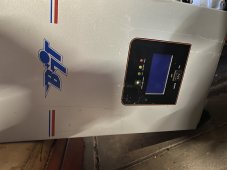

And what sized 12v battery would I need? Assuming 80% efficiency in the inverter (is that too generous?) the 12v DC supply would need to provide 315A to get 240v@3000w (@80%). You spoke about charging C rates, can I assume a discharge rate of 1C is safe? I know the manufacturers usually have figures for continuous, sustained and burst discharge rates, and sub-C is probably the safest (ie in regards to battery health), but 315A of 12v DC should be a reasonable goal for this inverter right? Maybe 3x 105Ah batteries in parallel?
It's a 12v DC, 240v AC 3000w inverter. It's been sitting in his shed unused since he bought the panels (used at the time, I assume).


And what sized 12v battery would I need? Assuming 80% efficiency in the inverter (is that too generous?) the 12v DC supply would need to provide 315A to get 240v@3000w (@80%). You spoke about charging C rates, can I assume a discharge rate of 1C is safe? I know the manufacturers usually have figures for continuous, sustained and burst discharge rates, and sub-C is probably the safest (ie in regards to battery health), but 315A of 12v DC should be a reasonable goal for this inverter right? Maybe 3x 105Ah batteries in parallel?
Last edited:
This sheet seems to applicable for the inverter:
Don B. Cilly
Energetic energy padawan
Well, as usual, labels are what they are. Indicative.
It's easy enough to find out what you bought. Considering age and all. Take one panel. Lay it on the ground, prop it up so it vaguely faces the sun. Measure voltage at wires. Then plug you multimeter's positive lead into the 10A socket. Measure short circuit current.
That is, short it with the meter. It's safe enough, you won't exceed the 10A.
Repeat with the other panels.
It's easy enough to find out what you bought. Considering age and all. Take one panel. Lay it on the ground, prop it up so it vaguely faces the sun. Measure voltage at wires. Then plug you multimeter's positive lead into the 10A socket. Measure short circuit current.
That is, short it with the meter. It's safe enough, you won't exceed the 10A.
Repeat with the other panels.
Don B. Cilly
Energetic energy padawan
On what battery, etc.
Personally, when working out a system, the way I'd go about it, first you try to estimate how much energy you're likely to use in 24h.
It never works, but at least it gives you an idea what ballpark you're in. :·)
Then you plan the battery(s). It's the core of the system, the really expensive part, the one that will give you the most joy or grief.
Then you try and work out how much you'd sensibly need to keep it charged. Panels, you can always add, and they're a lot cheaper than batteries - which you can always add, but it's not as simple to do.
Then you guesstimate the inverter.
If that one is cheap enough, sure, get it. Now, 3kW at 12V is... plain silly, but obviously, if you plan to draw some 100-150W most of the time with the occasional 800 or so, it should do just fine. Why have 3K if you plan to draw that much less? Because... it's better :·) And if you can get it cheap, better still.
.
Personally, when working out a system, the way I'd go about it, first you try to estimate how much energy you're likely to use in 24h.
It never works, but at least it gives you an idea what ballpark you're in. :·)
Then you plan the battery(s). It's the core of the system, the really expensive part, the one that will give you the most joy or grief.
Then you try and work out how much you'd sensibly need to keep it charged. Panels, you can always add, and they're a lot cheaper than batteries - which you can always add, but it's not as simple to do.
Then you guesstimate the inverter.
If that one is cheap enough, sure, get it. Now, 3kW at 12V is... plain silly, but obviously, if you plan to draw some 100-150W most of the time with the occasional 800 or so, it should do just fine. Why have 3K if you plan to draw that much less? Because... it's better :·) And if you can get it cheap, better still.
.
MichaelK
Solar Wizard
Personally, I think 3000W 12V inverters are a scam, and irresponsible to even market. It would take 250A to generate 3000W at 12V, and you are not likely to find a battery that you could ever pull that much amperage out of.
I'd avoid it like the plague.
I'd avoid it like the plague.
Don B. Cilly
Energetic energy padawan
True, but - as stated - if he plans a "reasonable" use for it - at that price, it would be good enough to start with. Quite resellable.
And to have an inverter that's rated for ten/twenty times your actual use, is a good thing, IMHO.
Once he's worked out what he wants/needs (which does take some testing/experimenting, doesn't it ;·), he can choose his voltage/inverter/sundry-auxiliaries accordingly. Panels he can rewire in series (or start in series anyway).
Batteries, they're simpler to grow in series than in parallel anyway, aren't they?
.
And to have an inverter that's rated for ten/twenty times your actual use, is a good thing, IMHO.
Once he's worked out what he wants/needs (which does take some testing/experimenting, doesn't it ;·), he can choose his voltage/inverter/sundry-auxiliaries accordingly. Panels he can rewire in series (or start in series anyway).
Batteries, they're simpler to grow in series than in parallel anyway, aren't they?
.
Similar threads
- Replies
- 34
- Views
- 751
- Replies
- 0
- Views
- 124
- Replies
- 13
- Views
- 474
- Replies
- 13
- Views
- 644


